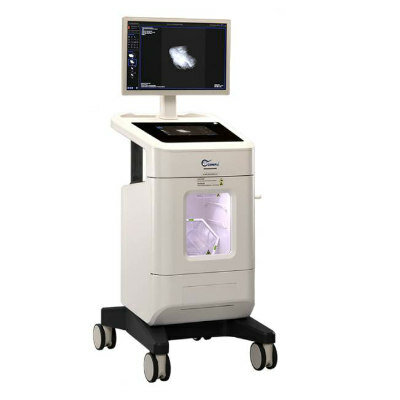Expo
view channel
view channel
view channel
view channel
view channel
view channel
view channel
view channel
view channel
Clinical Chem.Molecular DiagnosticsHematologyImmunologyMicrobiologyPathologyTechnologyIndustry
Events
Webinars

- Prostate Cancer Markers Based on Chemical Make-Up of Calcifications to Speed Up Detection
- Breath Test Could Help Detect Blood Cancers
- ML-Powered Gas Sensors to Detect Pathogens and AMR at POC
- Saliva-Based Cancer Detection Technology Eliminates Need for Complex Sample Preparation
- Skin Swabs Could Detect Parkinson’s Years Before Symptoms Appear
- Noninvasive Prenatal Test Detects Inherited Conditions
- Ultra-Sensitive Diagnostic Test Could Transform Global Health Care
- Rapid Test Detects Early Signs of Pneumonia in Critically Ill Patients
- Cell-Free RNA Test Could Detect Molecular Fingerprints of Chronic Fatigue Syndrome in Blood
- Simple Blood Test Could Detect Brain Insulin Resistance
- Portable and Disposable Device Obtains Platelet-Rich Plasma Without Complex Equipment
- Disposable Cartridge-Based Test Delivers Rapid and Accurate CBC Results
- First Point-of-Care Heparin Monitoring Test Provides Results in Under 15 Minutes
- New Scoring System Predicts Risk of Developing Cancer from Common Blood Disorder
- Non-Invasive Prenatal Test for Fetal RhD Status Demonstrates 100% Accuracy
- Novel Gene Signature Predicts Immunotherapy Response in Advanced Kidney Cancers
- New Technology Deciphers Immune Cell Communication to Predict Immunotherapy Response
- AI Model Accurately Predicts MSI Tumor and Immune Checkpoint Inhibitor Responsiveness
- Precision Tool Predicts Immunotherapy Treatment Failure in Melanoma Patients
- Paper-Based Device Accurately Detects Immune Defects in 10 Minutes
- Portable Spectroscopy Rapidly and Noninvasively Detects Bacterial Species in Vaginal Fluid
- CRISPR-Based Saliva Test Detects Tuberculosis Directly from Sputum
- Urine-Based Assay Diagnoses Common Lung Infection in Immunocompromised People
- Saliva Test Detects Implant-Related Microbial Risks
- New Platform Leverages AI and Quantum Computing to Predict Salmonella Antimicrobial Resistance
- Handheld Saliva Test Accurately Detects Breast Cancer
- Cutting-Edge AI Algorithms Enable Early Detection of Prostate Cancer
- New Microfluidic System Enables Early Cancer Diagnosis Using Simple Blood Tests
- AI to Transform Skin Cancer Diagnosis in Remote Areas
- Statistical Tool Identifies Genetic Changes Behind Neurological Conditions
- Pioneering Collaboration to Transform Pediatric Cancer Diagnostics and Research
- Bio-Techne Divests Exosome Diagnostics to Reposition Product Portfolio
- New Clinical Guidelines Recommend Use of Blood Tests Instead of Brain Scans for Alzheimer’s Diagnosis
- IFCC WorldLab 2026 To Be Held in India on October 25-29
- PHASE Scientific and Lumos Diagnostics Partner on Rapid POC Test for Bacterial Respiratory Infection
- Gene Panel Predicts Disease Progession for Patients with B-cell Lymphoma
- New Method Simplifies Preparation of Tumor Genomic DNA Libraries
- New Tool Developed for Diagnosis of Chronic HBV Infection
- Panel of Genetic Loci Accurately Predicts Risk of Developing Gout
- Disrupted TGFB Signaling Linked to Increased Cancer-Related Bacteria
- AI Tools Analyze Kidney Disease at Cellular Level to Help Tailor Treatments
- Fully Automated System Transforms Pre-Analytical Handling of Urine Specimens
- AI-Powered Test Offers Automated Quantitative Analysis of Fibrosis Assessment
- New Tool Exposes Hidden Cancer DNA Changes Driving Treatment Resistance
- Deep Learning Advances Imaging Mass Spectrometry with Virtual Histological Detail

 Expo
Expo
- Prostate Cancer Markers Based on Chemical Make-Up of Calcifications to Speed Up Detection
- Breath Test Could Help Detect Blood Cancers
- ML-Powered Gas Sensors to Detect Pathogens and AMR at POC
- Saliva-Based Cancer Detection Technology Eliminates Need for Complex Sample Preparation
- Skin Swabs Could Detect Parkinson’s Years Before Symptoms Appear
- Noninvasive Prenatal Test Detects Inherited Conditions
- Ultra-Sensitive Diagnostic Test Could Transform Global Health Care
- Rapid Test Detects Early Signs of Pneumonia in Critically Ill Patients
- Cell-Free RNA Test Could Detect Molecular Fingerprints of Chronic Fatigue Syndrome in Blood
- Simple Blood Test Could Detect Brain Insulin Resistance
- Portable and Disposable Device Obtains Platelet-Rich Plasma Without Complex Equipment
- Disposable Cartridge-Based Test Delivers Rapid and Accurate CBC Results
- First Point-of-Care Heparin Monitoring Test Provides Results in Under 15 Minutes
- New Scoring System Predicts Risk of Developing Cancer from Common Blood Disorder
- Non-Invasive Prenatal Test for Fetal RhD Status Demonstrates 100% Accuracy
- Novel Gene Signature Predicts Immunotherapy Response in Advanced Kidney Cancers
- New Technology Deciphers Immune Cell Communication to Predict Immunotherapy Response
- AI Model Accurately Predicts MSI Tumor and Immune Checkpoint Inhibitor Responsiveness
- Precision Tool Predicts Immunotherapy Treatment Failure in Melanoma Patients
- Paper-Based Device Accurately Detects Immune Defects in 10 Minutes
- Portable Spectroscopy Rapidly and Noninvasively Detects Bacterial Species in Vaginal Fluid
- CRISPR-Based Saliva Test Detects Tuberculosis Directly from Sputum
- Urine-Based Assay Diagnoses Common Lung Infection in Immunocompromised People
- Saliva Test Detects Implant-Related Microbial Risks
- New Platform Leverages AI and Quantum Computing to Predict Salmonella Antimicrobial Resistance
- Handheld Saliva Test Accurately Detects Breast Cancer
- Cutting-Edge AI Algorithms Enable Early Detection of Prostate Cancer
- New Microfluidic System Enables Early Cancer Diagnosis Using Simple Blood Tests
- AI to Transform Skin Cancer Diagnosis in Remote Areas
- Statistical Tool Identifies Genetic Changes Behind Neurological Conditions
- Pioneering Collaboration to Transform Pediatric Cancer Diagnostics and Research
- Bio-Techne Divests Exosome Diagnostics to Reposition Product Portfolio
- New Clinical Guidelines Recommend Use of Blood Tests Instead of Brain Scans for Alzheimer’s Diagnosis
- IFCC WorldLab 2026 To Be Held in India on October 25-29
- PHASE Scientific and Lumos Diagnostics Partner on Rapid POC Test for Bacterial Respiratory Infection
- Gene Panel Predicts Disease Progession for Patients with B-cell Lymphoma
- New Method Simplifies Preparation of Tumor Genomic DNA Libraries
- New Tool Developed for Diagnosis of Chronic HBV Infection
- Panel of Genetic Loci Accurately Predicts Risk of Developing Gout
- Disrupted TGFB Signaling Linked to Increased Cancer-Related Bacteria
- AI Tools Analyze Kidney Disease at Cellular Level to Help Tailor Treatments
- Fully Automated System Transforms Pre-Analytical Handling of Urine Specimens
- AI-Powered Test Offers Automated Quantitative Analysis of Fibrosis Assessment
- New Tool Exposes Hidden Cancer DNA Changes Driving Treatment Resistance
- Deep Learning Advances Imaging Mass Spectrometry with Virtual Histological Detail






















































